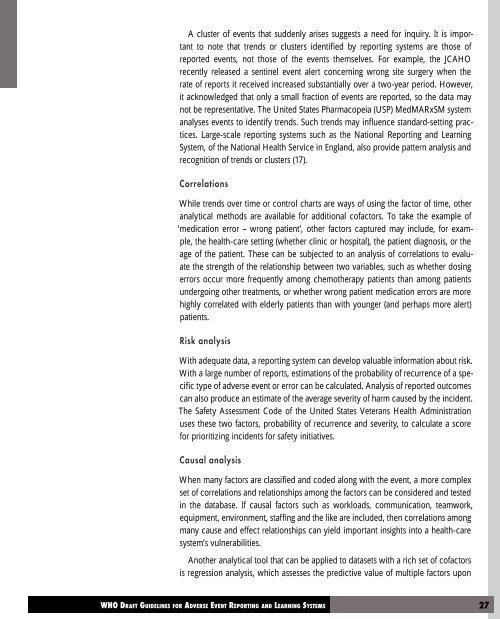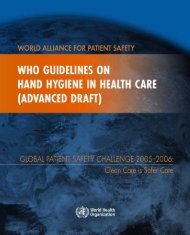Adverse event reporting.pdf
Adverse event reporting.pdf
Adverse event reporting.pdf
You also want an ePaper? Increase the reach of your titles
YUMPU automatically turns print PDFs into web optimized ePapers that Google loves.
A cluster of <strong>event</strong>s that suddenly arises suggests a need for inquiry. It is important<br />
to note that trends or clusters identified by <strong>reporting</strong> systems are those of<br />
reported <strong>event</strong>s, not those of the <strong>event</strong>s themselves. For example, the JCAHO<br />
recently released a sentinel <strong>event</strong> alert concerning wrong site surgery when the<br />
rate of reports it received increased substantially over a two-year period. However,<br />
it acknowledged that only a small fraction of <strong>event</strong>s are reported, so the data may<br />
not be representative. The United States Pharmacopeia (USP) MedMARxSM system<br />
analyses <strong>event</strong>s to identify trends. Such trends may influence standard-setting practices.<br />
Large-scale <strong>reporting</strong> systems such as the National Reporting and Learning<br />
System, of the National Health Service in England, also provide pattern analysis and<br />
recognition of trends or clusters (17).<br />
Correlations<br />
While trends over time or control charts are ways of using the factor of time, other<br />
analytical methods are available for additional cofactors. To take the example of<br />
‘medication error – wrong patient’, other factors captured may include, for example,<br />
the health-care setting (whether clinic or hospital), the patient diagnosis, or the<br />
age of the patient. These can be subjected to an analysis of correlations to evaluate<br />
the strength of the relationship between two variables, such as whether dosing<br />
errors occur more frequently among chemotherapy patients than among patients<br />
undergoing other treatments, or whether wrong patient medication errors are more<br />
highly correlated with elderly patients than with younger (and perhaps more alert)<br />
patients.<br />
Risk analysis<br />
With adequate data, a <strong>reporting</strong> system can develop valuable information about risk.<br />
With a large number of reports, estimations of the probability of recurrence of a specific<br />
type of adverse <strong>event</strong> or error can be calculated. Analysis of reported outcomes<br />
can also produce an estimate of the average severity of harm caused by the incident.<br />
The Safety Assessment Code of the United States Veterans Health Administration<br />
uses these two factors, probability of recurrence and severity, to calculate a score<br />
for prioritizing incidents for safety initiatives.<br />
Causal analysis<br />
When many factors are classified and coded along with the <strong>event</strong>, a more complex<br />
set of correlations and relationships among the factors can be considered and tested<br />
in the database. If causal factors such as workloads, communication, teamwork,<br />
equipment, environment, staffing and the like are included, then correlations among<br />
many cause and effect relationships can yield important insights into a health-care<br />
system’s vulnerabilities.<br />
Another analytical tool that can be applied to datasets with a rich set of cofactors<br />
is regression analysis, which assesses the predictive value of multiple factors upon
















